Transformer代码详解: attention-is-all-you-need-pytorch
from: https://zhuanlan.zhihu.com/p/463052305
参考:
attention-is-all-you-need-pytorch
Transformer代码详解-pytorch版
Transformer模型结构
Transformer模型结构如下图:
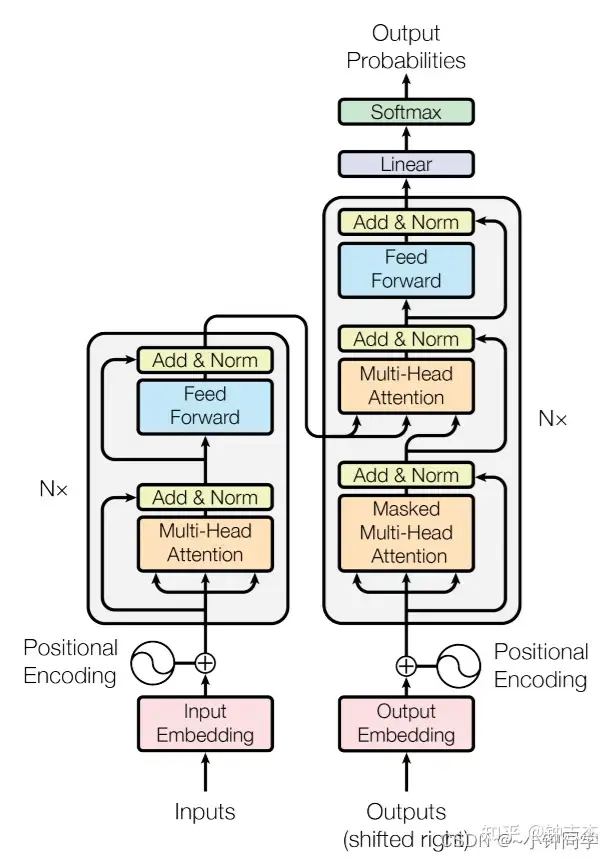
- Transformer的整体结构就是分成Encoder和Decoder两部分,并且两部分之间是有联系的,可以注意到Encoder的输出是Decoder第二个Multi-head Attention中和的输入。
- Encoder和Decoder分别由N个EncoderLayer和DecoderLayer组成。N默认为6个。
- EncoderLayer由两个SubLayers组成,分别是Multi-head Attention和Feed Forward。DecoderLayer则是由三个SubLayers组成,分别是Masked Multi-head Attention,Multi-head Attention和Feed Forward。
- Multi-head Attention是用ScaledDotProductAttention和Linear组成。Feed Forward是由Linear组成。
- Add & Norm指的是残差连接之后再进行LayerNorm。
各模块结构结构
Multi-head Attention结构

Feed Forward结构
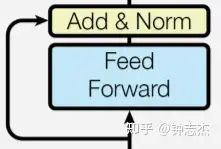
EncoderLayer结构
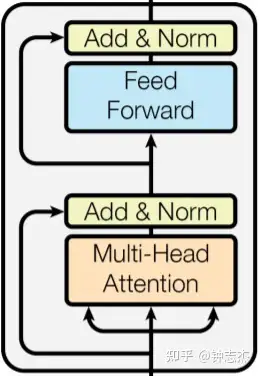
DecoderLayer结构
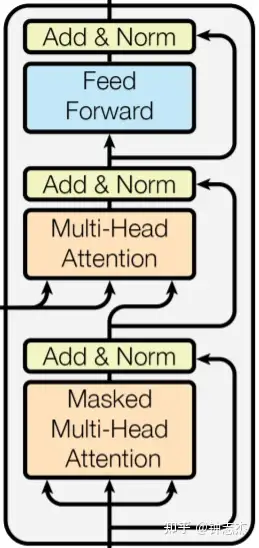
Encoder结构
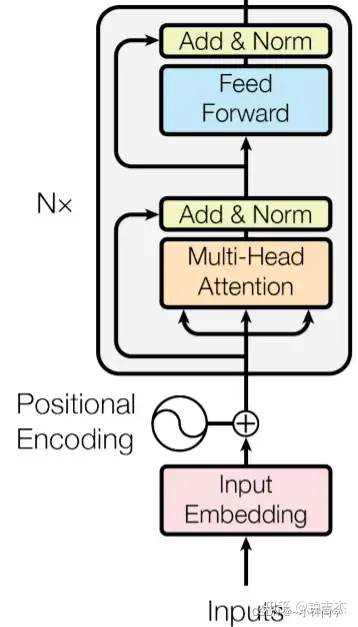
Decoder结构

ScaledDotProductAttention模块
ScaledDotProductAttention做的是一个attention计算。公式如下:

输入q k v,可以q先除以根号d_k(d_k默认为64,根号d_k就为8),再与k的转置相乘,再经过softmax,最后与v相乘。下图的操作和公式所做的东西是一样的。
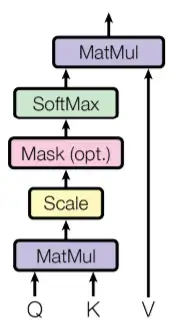
class ScaledDotProductAttention(nn.Module):
''' Scaled Dot-Product Attention '''
def __init__(self, temperature, attn_dropout=0.1):
super().__init__()
# 其实就是论文中的根号d_k
self.temperature = temperature
self.dropout = nn.Dropout(attn_dropout)
def forward(self, q, k, v, mask=None):
# sz_b: batch_size 批量大小
# len_q,len_k,len_v: 序列长度 在这里他们都相等
# n_head: 多头注意力 默认为8
# d_k,d_v: k v 的dim(维度) 默认都是64
# 此时q的shape为(sz_b, n_head, len_q, d_k) (sz_b, 8, len_q, 64)
# 此时k的shape为(sz_b, n_head, len_k, d_k) (sz_b, 8, len_k, 64)
# 此时v的shape为(sz_b, n_head, len_k, d_v) (sz_b, 8, len_k, 64)
# q先除以self.temperature(论文中的根号d_k) k交换最后两个维度(这样才可以进行矩阵相乘) 最后两个张量进行矩阵相乘
# attn的shape为(sz_b, n_head, len_q, len_k)
attn = torch.matmul(q / self.temperature, k.transpose(2, 3))
if mask is not None:
# 用-1e9代替0 -1e9是一个很大的负数 经过softmax之后接近与0
# 其一:去除掉各种padding在训练过程中的影响
# 其二,将输入进行遮盖,避免decoder看到后面要预测的东西。(只用在decoder中)
attn = attn.masked_fill(mask == 0, -1e9)
# 先在attn的最后一个维度做softmax 再dropout 得到注意力分数
attn = self.dropout(F.softmax(attn, dim=-1))
# 最后attn与v进行矩阵相乘
# output的shape为(sz_b, 8, len_q, 64)
output = torch.matmul(attn, v)
# 返回 output和注意力分数
return output, attnMultiHeadAttention和PositionwiseFeedForward模块
MultiHeadAttention做的是将q k v先经过线性层投影,再做ScaledDotProductAttention ,最后经过一个线性层。也就是下图的操作:
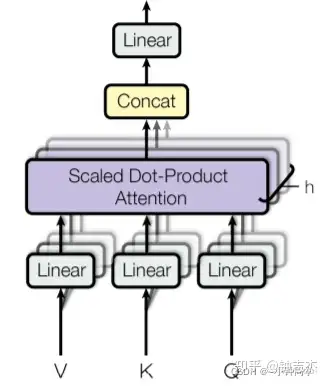
对应着Transformer的模块是:

PositionwiseFeedForward其实就是MLP。对应着Transformer的模块是:

# q k v 先经过不同的线性层 再用ScaledDotProductAttention 最后再经过一个线性层
class MultiHeadAttention(nn.Module):
''' Multi-Head Attention module '''
def __init__(self, n_head, d_model, d_k, d_v, dropout=0.1):
# 这里的n_head, d_model, d_k, d_v分别默认为8, 512, 64, 64
super().__init__()
self.n_head = n_head
self.d_k = d_k
self.d_v = d_v
self.w_qs = nn.Linear(d_model, n_head * d_k, bias=False)
self.w_ks = nn.Linear(d_model, n_head * d_k, bias=False)
self.w_vs = nn.Linear(d_model, n_head * d_v, bias=False)
self.fc = nn.Linear(n_head * d_v, d_model, bias=False)
self.attention = ScaledDotProductAttention(temperature=d_k ** 0.5)
self.dropout = nn.Dropout(dropout)
self.layer_norm = nn.LayerNorm(d_model, eps=1e-6)
def forward(self, q, k, v, mask=None):
d_k, d_v, n_head = self.d_k, self.d_v, self.n_head
# len_q, len_k, len_v 为输入的序列长度
sz_b, len_q, len_k, len_v = q.size(0), q.size(1), k.size(1), v.size(1)
# 用作残差连接
residual = q
# Pass through the pre-attention projection: b x lq x (n*dv)
# Separate different heads: b x lq x n x dv
# q k v 分别经过一个线性层再改变维度
# 由(sz_b, len_q, n_head*d_k) => (sz_b, len_q, n_head, d_k) (sz_b, len_q, 8*64) => (sz_b, len_q, 8, 64)
q = self.w_qs(q).view(sz_b, len_q, n_head, d_k)
k = self.w_ks(k).view(sz_b, len_k, n_head, d_k)
v = self.w_vs(v).view(sz_b, len_v, n_head, d_v)
# Transpose for attention dot product: b x n x lq x dv
# 交换维度做attention
# 由(sz_b, len_q, n_head, d_k) => (sz_b, n_head, len_q, d_k) (sz_b, len_q, 8, 64) => (sz_b, 8, len_q, 64)
q, k, v = q.transpose(1, 2), k.transpose(1, 2), v.transpose(1, 2)
if mask is not None:
# 为head增加一个维度
mask = mask.unsqueeze(1) # For head axis broadcasting.
# 做attention
q, attn = self.attention(q, k, v, mask=mask)
# Transpose to move the head dimension back: b x lq x n x dv
# Combine the last two dimensions to concatenate all the heads together: b x lq x (n*dv)
# (sz_b, 8, len_k, 64) => (sz_b, len_k, 8, 64) => (sz_b, len_k, 512)
q = q.transpose(1, 2).contiguous().view(sz_b, len_q, -1)
# 经过fc和dropout
q = self.dropout(self.fc(q))
# 残差连接 论文中的Add & Norm中的Add
q += residual
# 论文中的Add & Norm中的Norm
q = self.layer_norm(q)
# q的shape为(sz_b, len_q, 512)
# attn的shape为(sz_b, n_head, len_q, len_k)
return q, attn
# 其实就是一个MLP而已
class PositionwiseFeedForward(nn.Module):
''' A two-feed-forward-layer module '''
def __init__(self, d_in, d_hid, dropout=0.1):
# d_in默认为512 d_hid默认为2048
super().__init__()
self.w_1 = nn.Linear(d_in, d_hid) # position-wise
self.w_2 = nn.Linear(d_hid, d_in) # position-wise
self.layer_norm = nn.LayerNorm(d_in, eps=1e-6)
self.dropout = nn.Dropout(dropout)
def forward(self, x):
residual = x
x = self.w_2(F.relu(self.w_1(x)))
x = self.dropout(x)
# 下面两句对应论文中的Add & Norm中
x += residual
x = self.layer_norm(x)
return xEncoderLayer和DecoderLayer模块
EncoderLayer由两个SubLayers组成,分别是Multi-head Attention和Feed Forward。对应着Transformer的模块是:

DecoderLayer则是由三个SubLayers组成,分别是Masked Multi-head Attention,Multi-head Attention和Feed Forward。对应着Transformer的模块是:

class EncoderLayer(nn.Module):
''' Compose with two layers '''
def __init__(self, d_model, d_inner, n_head, d_k, d_v, dropout=0.1):
# d_model, d_inner, n_head, d_k, d_v分别默认为512, 2048, 8, 64, 64
super(EncoderLayer, self).__init__()
self.slf_attn = MultiHeadAttention(n_head, d_model, d_k, d_v, dropout=dropout)
self.pos_ffn = PositionwiseFeedForward(d_model, d_inner, dropout=dropout)
def forward(self, enc_input, slf_attn_mask=None):
# q k v都是enc_input
enc_output, enc_slf_attn = self.slf_attn(
enc_input, enc_input, enc_input, mask=slf_attn_mask)
enc_output = self.pos_ffn(enc_output)
# enc_output的shape为(sz_b, len_q, 512)
# enc_slf_attn的shape为(sz_b, n_head, len_q, len_k)
return enc_output, enc_slf_attn
class DecoderLayer(nn.Module):
''' Compose with three layers '''
def __init__(self, d_model, d_inner, n_head, d_k, d_v, dropout=0.1):
super(DecoderLayer, self).__init__()
# 这里的第一个MultiHeadAttention是带Masked
self.slf_attn = MultiHeadAttention(n_head, d_model, d_k, d_v, dropout=dropout)
self.enc_attn = MultiHeadAttention(n_head, d_model, d_k, d_v, dropout=dropout)
self.pos_ffn = PositionwiseFeedForward(d_model, d_inner, dropout=dropout)
def forward(
self, dec_input, enc_output,
slf_attn_mask=None, dec_enc_attn_mask=None):
# q k v都是dec_input
dec_output, dec_slf_attn = self.slf_attn(
dec_input, dec_input, dec_input, mask=slf_attn_mask)
# q是dec_output k和v是enc_output
dec_output, dec_enc_attn = self.enc_attn(
dec_output, enc_output, enc_output, mask=dec_enc_attn_mask)
dec_output = self.pos_ffn(dec_output)
# dec_output的shape为(sz_b, len_q, 512)
# dec_slf_attn的shape为(sz_b, n_head, len_q, len_k)
# dec_enc_attn的shape为(sz_b, n_head, len_q, len_k)
return dec_output, dec_slf_attn, dec_enc_attnEncoder和Decoder模块
- padding mask:处理非定长序列,区分padding和非padding部分。对应下面get_pad_mask()函数,用于Encoder中。
- sequence mask:防止标签泄露。sequence mask 一般是通过生成一个上三角为0的矩阵来实现的,上三角区域对应要mask的部分。对于下面的get_subsequent_mask()函数。
- Transformer代码中Decoder使用的mask是get_pad_mask()得到的结果和get_subsequent_mask()得到的结果进行与运算(&)。我认为是既要区分padding和非padding部分,也要防止标签泄露。
# get_pad_mask()得到的结果和get_subsequent_mask()得到的结果进行与运算(&)
# [[[1 0 0] [[[1 0 0]
# [[[1 1 0]]] & [1 1 0] = [1 1 0]
# [1 1 1]]] [1 1 0]]]
# 获取mask并增加一个维度
# pad_idx一般为0
# (batch_size, seq_len) => (batch_size, 1, seq_len) (1, 3) => (1, 1, 3)
# 如输入seq为[[1,2,0]] 输出为 [[[1 1 0]]]
def get_pad_mask(seq, pad_idx):
return (seq != pad_idx).unsqueeze(-2)
def get_subsequent_mask(seq):
''' For masking out the subsequent info. '''
sz_b, len_s = seq.size()
# 例如输入的seq的shape为(1, 3)
# torch.triu(torch.ones((1, len_s, len_s), device=seq.device), diagonal=1))的结果是:
# [[[0 1 1]
# [0 0 1]
# [0 0 0]]]
# [[[1 0 0]
# subsequent_mask = [1 1 0]
# [1 1 1]]]
# get_pad_mask()得到的结果和get_subsequent_mask()得到的结果进行与运算(&)
# [[[1 0 0] [[[1 0 0]
# [[[1 1 0]]] & [1 1 0] = [1 1 0]
# [1 1 1]]] [1 1 0]]]
subsequent_mask = (1 - torch.triu(
torch.ones((1, len_s, len_s), device=seq.device), diagonal=1)).bool()
return subsequent_mask相比于rnn,attention缺少了位置信息,需要在输出的时候加上位置信息,位置编码的公式如下:

- pos的范围是[0,200),pos=[0,1,2,3,......,199],长度=200 - i的范围是[0,256), i=[0,0,1,1,2,2,......,255,255],长度=512 - 代码是先计算出
![]()
在偶数位置,也就是偶数列再进行sin运算;在奇数位置,也就是奇数列再进行cos运算。 位置编码对应着Transformer的模块是:
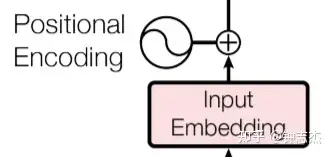
class PositionalEncoding(nn.Module):
def __init__(self, d_hid, n_position=200):
super(PositionalEncoding, self).__init__()
# Not a parameter
self.register_buffer('pos_table', self._get_sinusoid_encoding_table(n_position, d_hid))
def _get_sinusoid_encoding_table(self, n_position, d_hid):
# n_position默认为200 d_hid默认为d512
''' Sinusoid position encoding table '''
# TODO: make it with torch instead of numpy
# 利用论文中的公式获取某个位置的向量
def get_position_angle_vec(position):
# 长度为512 (hid_j // 2)就是论文中的i
return [position / np.power(10000, 2 * (hid_j // 2) / d_hid) for hid_j in range(d_hid)]
# shape为(200, 512)
sinusoid_table = np.array([get_position_angle_vec(pos_i) for pos_i in range(n_position)])
# 偶数位置使用sin编码
sinusoid_table[:, 0::2] = np.sin(sinusoid_table[:, 0::2]) # dim 2i
# 奇数位置使用cos编码
sinusoid_table[:, 1::2] = np.cos(sinusoid_table[:, 1::2]) # dim 2i+1
# shape为(1, n_position, d_hid)
return torch.FloatTensor(sinusoid_table).unsqueeze(0)
def forward(self, x):
# n_position默认为200 seq_len不会超过200
# 这里x加入位置编码
return x + self.pos_table[:, :x.size(1)].clone().detach()Encoder对应着Transformer的模块是:

class Encoder(nn.Module):
''' A encoder model with self attention mechanism. '''
def __init__(
self, n_src_vocab, d_word_vec, n_layers, n_head, d_k, d_v,
d_model, d_inner, pad_idx, dropout=0.1, n_position=200, scale_emb=False):
# n_src_vocab: 源语言词汇表的大小
# d_word_vec: 词嵌入的维度
super().__init__()
# padding_idx如果指定 则padding_idx处的条目不会影响梯度 因此padding_idx 处的嵌入向量在训练期间不会更新 即它仍然是一个固定的"pad"
self.src_word_emb = nn.Embedding(n_src_vocab, d_word_vec, padding_idx=pad_idx)
self.position_enc = PositionalEncoding(d_word_vec, n_position=n_position)
self.dropout = nn.Dropout(p=dropout)
# Encoder包含了n_layers个EncoderLayer n_layers默认为6
self.layer_stack = nn.ModuleList([
EncoderLayer(d_model, d_inner, n_head, d_k, d_v, dropout=dropout)
for _ in range(n_layers)])
self.layer_norm = nn.LayerNorm(d_model, eps=1e-6)
self.scale_emb = scale_emb
self.d_model = d_model
def forward(self, src_seq, src_mask, return_attns=False):
# src_seq: 输入的序列
# src_mask: get_pad_mask()得到的结果
enc_slf_attn_list = []
# -- Forward
# 词嵌入
enc_output = self.src_word_emb(src_seq)
if self.scale_emb:
enc_output *= self.d_model ** 0.5
# 加上位置编码
enc_output = self.dropout(self.position_enc(enc_output))
enc_output = self.layer_norm(enc_output)
# n_layers个EncoderLayer串联在一起
for enc_layer in self.layer_stack:
enc_output, enc_slf_attn = enc_layer(enc_output, slf_attn_mask=src_mask)
enc_slf_attn_list += [enc_slf_attn] if return_attns else []
if return_attns:
return enc_output, enc_slf_attn_list
return enc_output,Decoder对应着Transformer的模块是:

class Decoder(nn.Module):
''' A decoder model with self attention mechanism. '''
def __init__(
self, n_trg_vocab, d_word_vec, n_layers, n_head, d_k, d_v,
d_model, d_inner, pad_idx, n_position=200, dropout=0.1, scale_emb=False):
# n_trg_vocab: 翻译后语言词汇表的大小
# d_word_vec: 词嵌入的维度
super().__init__()
self.trg_word_emb = nn.Embedding(n_trg_vocab, d_word_vec, padding_idx=pad_idx)
self.position_enc = PositionalEncoding(d_word_vec, n_position=n_position)
self.dropout = nn.Dropout(p=dropout)
# Decoder包含了n_layers个DecoderLayer n_layers默认为6
self.layer_stack = nn.ModuleList([
DecoderLayer(d_model, d_inner, n_head, d_k, d_v, dropout=dropout)
for _ in range(n_layers)])
self.layer_norm = nn.LayerNorm(d_model, eps=1e-6)
self.scale_emb = scale_emb
self.d_model = d_model
def forward(self, trg_seq, trg_mask, enc_output, src_mask, return_attns=False):
# trg_seq:翻译后语言序列
# trg_mask: get_pad_mask()得到的结果和get_subsequent_mask()得到的结果进行与运算(&)
# enc_output: Encoder的输出
# src_mask: get_pad_mask()得到的结果
dec_slf_attn_list, dec_enc_attn_list = [], []
# -- Forward
# 词嵌入
dec_output = self.trg_word_emb(trg_seq)
if self.scale_emb:
dec_output *= self.d_model ** 0.5
# 加上位置编码
dec_output = self.dropout(self.position_enc(dec_output))
dec_output = self.layer_norm(dec_output)
# n_layers个DecoderLayer串联在一起
for dec_layer in self.layer_stack:
dec_output, dec_slf_attn, dec_enc_attn = dec_layer(
dec_output, enc_output, slf_attn_mask=trg_mask, dec_enc_attn_mask=src_mask)
dec_slf_attn_list += [dec_slf_attn] if return_attns else []
dec_enc_attn_list += [dec_enc_attn] if return_attns else []
if return_attns:
return dec_output, dec_slf_attn_list, dec_enc_attn_list
return dec_output,Transformer
class Transformer(nn.Module):
''' A sequence to sequence model with attention mechanism. '''
def __init__(
self, n_src_vocab, n_trg_vocab, src_pad_idx, trg_pad_idx,
d_word_vec=512, d_model=512, d_inner=2048,
n_layers=6, n_head=8, d_k=64, d_v=64, dropout=0.1, n_position=200,
trg_emb_prj_weight_sharing=True, emb_src_trg_weight_sharing=True,
scale_emb_or_prj='prj'):
super().__init__()
self.src_pad_idx, self.trg_pad_idx = src_pad_idx, trg_pad_idx
# In section 3.4 of paper "Attention Is All You Need", there is such detail:
# "In our model, we share the same weight matrix between the two
# embedding layers and the pre-softmax linear transformation...
# In the embedding layers, we multiply those weights by \sqrt{d_model}".
#
# Options here:
# 'emb': multiply \sqrt{d_model} to embedding output
# 'prj': multiply (\sqrt{d_model} ^ -1) to linear projection output
# 'none': no multiplication
assert scale_emb_or_prj in ['emb', 'prj', 'none']
scale_emb = (scale_emb_or_prj == 'emb') if trg_emb_prj_weight_sharing else False
self.scale_prj = (scale_emb_or_prj == 'prj') if trg_emb_prj_weight_sharing else False
self.d_model = d_model
self.encoder = Encoder(
n_src_vocab=n_src_vocab, n_position=n_position,
d_word_vec=d_word_vec, d_model=d_model, d_inner=d_inner,
n_layers=n_layers, n_head=n_head, d_k=d_k, d_v=d_v,
pad_idx=src_pad_idx, dropout=dropout, scale_emb=scale_emb)
self.decoder = Decoder(
n_trg_vocab=n_trg_vocab, n_position=n_position,
d_word_vec=d_word_vec, d_model=d_model, d_inner=d_inner,
n_layers=n_layers, n_head=n_head, d_k=d_k, d_v=d_v,
pad_idx=trg_pad_idx, dropout=dropout, scale_emb=scale_emb)
self.trg_word_prj = nn.Linear(d_model, n_trg_vocab, bias=False)
for p in self.parameters():
if p.dim() > 1:
nn.init.xavier_uniform_(p)
assert d_model == d_word_vec, \
'To facilitate the residual connections, \
the dimensions of all module outputs shall be the same.'
# Decoder中Embedding层和FC层权重共享
# Embedding层参数维度是:(v,d),FC层参数维度是:(d,v),可以直接共享嘛,还是要转置?其中v是词表大小,d是embedding维度。
# 查看 pytorch 源码发现真的可以直接共享:
if trg_emb_prj_weight_sharing:
# Share the weight between target word embedding & last dense layer
self.trg_word_prj.weight = self.decoder.trg_word_emb.weight
# Encoder和Decoder间的Embedding层权重共享
if emb_src_trg_weight_sharing:
self.encoder.src_word_emb.weight = self.decoder.trg_word_emb.weight
def forward(self, src_seq, trg_seq):
src_mask = get_pad_mask(src_seq, self.src_pad_idx)
trg_mask = get_pad_mask(trg_seq, self.trg_pad_idx) & get_subsequent_mask(trg_seq)
enc_output, *_ = self.encoder(src_seq, src_mask)
dec_output, *_ = self.decoder(trg_seq, trg_mask, enc_output, src_mask)
seq_logit = self.trg_word_prj(dec_output)
if self.scale_prj:
seq_logit *= self.d_model ** -0.5
return seq_logit.view(-1, seq_logit.size(2))



【推荐】国内首个AI IDE,深度理解中文开发场景,立即下载体验Trae
【推荐】编程新体验,更懂你的AI,立即体验豆包MarsCode编程助手
【推荐】抖音旗下AI助手豆包,你的智能百科全书,全免费不限次数
【推荐】轻量又高性能的 SSH 工具 IShell:AI 加持,快人一步
· TypeScript + Deepseek 打造卜卦网站:技术与玄学的结合
· Manus的开源复刻OpenManus初探
· AI 智能体引爆开源社区「GitHub 热点速览」
· 三行代码完成国际化适配,妙~啊~
· .NET Core 中如何实现缓存的预热?